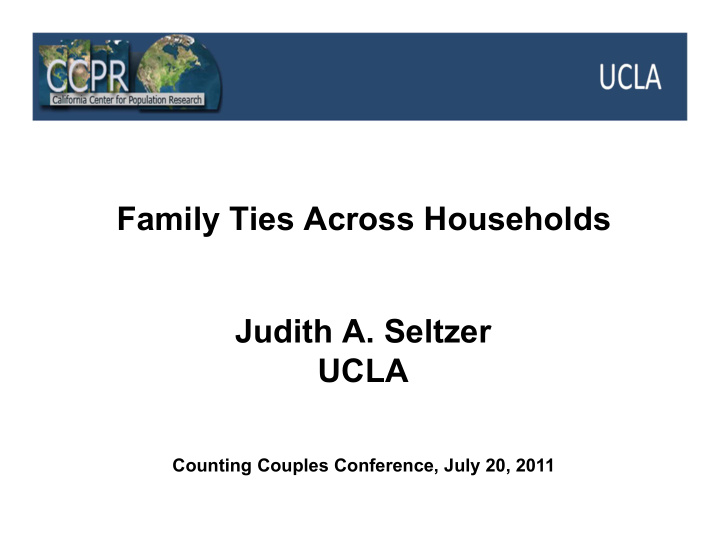



Family Ties Across Households Judith A. Seltzer UCLA Counting Couples Conference, July 20, 2011
Family Complexity and Complex Data Increasingly complex families Parents and minor children who live apart Multi-partner fertility Step and quasi-step relationships Extended transition to adulthood Data improvements Federal surveys and researcher initiated Data Assessment: Bianchi et al., CCPR 2007-020 http://papers.ccpr.ucla.edu/papers/PWP-CCPR-2007-020/PWP-CCPR-2007-020.pdf 2
Taking Stock of the Questions Who helps a family member who is not living with them? How is help associated with the well- being of those who give help and those who receive it? How do legal arrangements (custody, support) affect relationships between parents and children who live apart? 3
Demographic Perspective Identify the population Geography matters Determining who lives here Potential transfers: The missing piece Looking to the future 4
Identify the Population Kin Availability Need to know who helps and who does not Nonresident fathers; Elderly parents Children vs. Mothers vs. Fathers Birth cohort vs. cross-sectional samples 1 parent, 1+ children Parents older than age 44 Mother sample ≠ father sample Biological + social parents 5
Geography Matters State laws, economic opportunities CPS-CSS – same state Q Proximity associated with care Description vs. causation Measurement Coordinates, travel time, miles apart Evaluate reports vs. coordinates (HRS) 6
Determining Who Lives Here Household rosters taken for granted Rs’ vs. researchers’ residence rules Ambiguous situations 2000 census – joint custody duplicates Youths transitioning from parents’ household Getting residence right Geographic location Skip patterns Need clear rules communicated clearly 7
Potential Transfers: The Missing Piece Family as safety net Theoretical importance extends beyond family in the household Who could get help? Who expects to give it? Data on kin availability, needs/resources, perceived obligation Behavior vs. attitudes Module – Add Health, NLSY97, PSID 8
Looking to the Future New technology for keeping in touch Do new modes change cross-household ties? Multi-partner fertility increases complexity of reporting tasks More ambiguous living situations are challenge for HH rosters Downstream effect on question sequences and… 9
Looking to the Future, Continued Aging of cohorts with high family instability Family provides most informal care. AND most elderly live independently Cross-hh data essential for policy Yours, mine, our children Separate reports from spouses/partners Gender differences; bio vs. “step” vs. “former” step parents Respondent burden; Research need 10
Recommend
More recommend